Este post também está disponível em:
Português
English
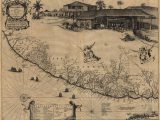
Sugarcane originated in distant Papua (New Guinea), where it was already known about 12,000 years ago, and then cultivated in South Asia, it was sugarcane (Saccharum officinarum L.) brought by the Arabs from Africa to Sicily and from there to the southern coast of Spain.
Among the Portuguese, sugar cane cultivation began in the Algarve at the time of King João I (1404), and was later transported by Prince Henry the Navigator to Madeira Island, which made it the great propellant of progress in the colonial world of the time.
From being a product sold in European apothecaries in the 14th century, integrating the Arab cuisine that dominated the Iberian Peninsula for three centuries and tried to develop the planting of sugar cane in Granada, sugar arrived in Portugal “as a medicine and a treat, parsimonious in rich people”.
The first sugar cane seedlings were planted on the island of Madeira in 1425, brought from Sicily by order of Prince Henry the Navigator and planted in the centre of Funchal, near the Terreiro da Sé.
The cultivation of sugar cane soon developed and, in 1455, production was estimated at 6000 arrobas. In 1498, two years before the discovery of Brazil, Dom Manuel, King of Portugal, already set the export of the islands – Madeira, Azores, São Tomé and Cape Verde – at 120,000 arrobas.
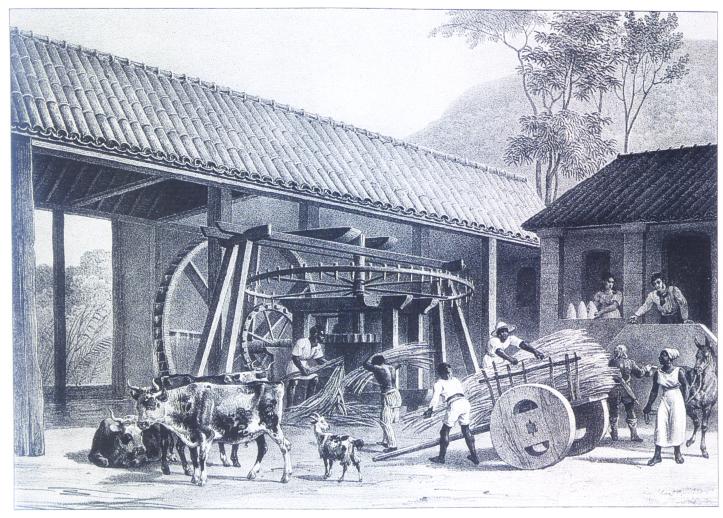
At the end of the 15th century, the confectionery industry in Portugal was already centuries old, with its honey cakes, alfenim and alféloa, which originated in Arab cuisine.
It is from this time that the Cortes of Évora represented against the alfeloeiras who, among other damages, made “the boys cry and ask their parents for more money to buy said alféloa”; hence the prohibition of Dom Manuel, punishing the transgression with imprisonment and flogging, of the trade of this sweet to be exercised by men.
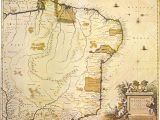
The sugar produced on the island of Madeira had become known in Europe at the time.
The episode in which Captain Simão Gonçalves da Câmara, a Madeiran well known for his liberality, sent as a gift to Pope Leo X (1513-1521) a life-size sculpture in alphene with all the cardinals of the Sacred College.
Although it was officially introduced in Brazil by Martin Afonso de Souza in 1532, sugar cane had already been part of the Pernambuco landscape since the early days of colonisation, even at the time of Cristóvão Jacques’ trading post in the Itamaracá Canal (1516).
In 1526, the payment of duties on sugar from Pernambuco was already mentioned in the Lisbon Customs House, according to information revealed for the first time by F. A. Varnhagen.
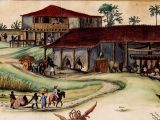
With the implementation of the hereditary captaincy system in Brazil, the territory of the captaincy of Pernambuco was donated to Duarte Coelho Pereira, who had rendered the crown relevant services in the conquest of the Indies.
The territory that constituted the primitive Captaincy of Pernambuco was established when the donation was made by King João III to Duarte Coelho Pereira, on l0 March 1534 and comprised:
Sixty leagues of land … which will begin at the São Francisco River […] and will end at the river that surrounds in round all the Island of Itamaracá, to which now again I put the name Rio Santa Cruz … and the land on the south side will remain with the said Duarte Coelho, and the said river where Cristóvão Jacques made the first house of my trading post and fifty paces from the said trading post along the river inwards along the beach a standard of my arms will be placed, and from the said standard a line will be thrown to the west along the terra firma inwards and the land of the said line to the south will belong to the said Duarte Coelho, and from the said standard down the river to the bar and the sea, Duarte Coelho will also own half of the said river of Santa Cruz to the south, and thus the whole of the said river of São Francisco and half of the river of Santa Cruz will enter the said land and its demarcation by the aforesaid demarcation, by which rivers he will give service to his neighbours, on the one hand and on the other, and since there are some islands on the border of the said demarcation, it is my good pleasure that they belong to the said Duarte Coelho, and annex them to this captaincy of his, the said islands being up to ten leagues to the sea on the front of the said demarcation by the eastern line, which line will extend from the middle of the bar of the said Rio de Santa Cruz, cutting wide along the coast, and will enter the same width through the hinterland and terra firme adentro, as much as they can enter and is of my conquest …
The southern half of the Itamaracá channel – which King João III called the “river” of Santa Cruz – up to fifty paces beyond the site of the original trading post of Cristóvão Jacques, demarcated the northern limit of Pernambuco; to the south, the limit of the captaincy was the River São Francisco, in all its width and extension, including all its islands from its mouth to its source.
Thus the territory of the Captaincy of Pernambuco inflected to the south-west, following the course of the river, reaching its sources in the present state of Minas Gerais.
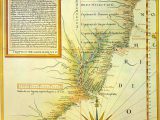
To the north, the King established a line westwards, through the land, to the limits of his conquest; that is, those defined by the Treaty of Tordesillas (1493), that is, the lands situated beyond 370 leagues west of the Cape Verde Islands.
The borders of the Duartina captaincy were roughly established, whose sixty leagues of frontage covered the whole of the present-day state of Alagoas and ended to the south at the River São Francisco, bordering the present-day state of Minas Gerais.
Thanks to the possession of this important watercourse, in all its length and breadth, the territory of Pernambuco grew in a south-westerly direction, far exceeding the sixty leagues established in the donation charter.
According to F. A. Varnhagen, Duarte Coelho’s captaincy had twelve thousand square leagues, making it the largest territorial area of all those distributed by King João III.
Arriving at the Pernambuco factory on 9 March 1535, Duarte Coelho was accompanied by his wife, Brites de Albuquerque, his brother-in-law Jerônimo de Albuquerque, and some families from northern Portugal who had come to try their luck in the development of the sugarcane agroindustry.
This “founder of the nation” was responsible for systematically laying the foundations of the sugar agroindustry. He brought new sugar-making techniques with the arrival of mills and specialised masters from the island of Madeira and, above all, the import of Jewish capital to finance the enterprise.
The first sugar mill in Pernambuco, Engenho Velho de Beberibe, was built in the early years of colonisation by Jerônimo de Albuquerque, under the invocation of Nossa Senhora da Ajuda.
This was the first of hundreds that followed, starting an economy based on sugar cane cultivation, founded by the grantee Duarte Coelho, who sent for sugar masters on the island of Madeira and imported slave labour from Africa, where the first blacks from Guinea came from.
The cultivation of sugar cane brought new colours, customs, smells and flavours to the landscape, thus contributing to the development and overpowering of the land of Pernambuco, whose beginnings were seen in this way by Oliveira Lima:
The captaincy of Duarte Coelho was the one that prospered the earliest, although at the cost of much expense and effort, because, in addition to the unusual personal qualities of the donee, the land recommended itself by its excellence. The climate was hot, but tempered by the gentle turns of land and sea so often spoken of by Piso, the wise physician of Maurício de Nassau. Abundant and regular rainfall throughout the hinterland, refreshing the fields, thickening the rivers and preventing droughts. The terrain is not too rugged, gradually descending from the plateaus or tablelands of the interior to the leafy forests, where the vigour does not outweigh the beauty, and to the fertile floodplains bathed by many rivers, and expiring in the mangroves or flooded areas of the sea.
In Pernambuco, the “terra garanhona do massapê”, to use Gilberto Freyre’s expression, was the ideal soil for the foundation of this culture that for more than four centuries has dominated the economy of an entire region.
With its sugar mills spread across the floodplains of the Capibaribe, Beberibe, Jaboatão and Una rivers, the Duartina Captaincy saw the sugar civilisation flourish.
For the first grantee, Nova Lusitânia, as he insisted on calling Pernambuco, would never be a simply extractive colony, as the Lisbon orders wanted in the first half of the 16th century, but a land of plantations, the embryo of what became the sugar civilisation.
This product was the economic support for the great civilising march of Pernambuco, responsible for the colonisation of the whole of northern Brazil.
Sugar was the great economic driver of these conquests; sugar that, in 1583, was produced by 66 mills.
The economic situation of the captaincy at the beginning of the 17th century was, in the words of Friar Vicente do Salvador (c. 1564 – c. 1636-39), one of the best, with the most frequented port in Brazil and an income of twenty thousand cruzados, “apart from the brazilwood and the sugar duties”.
Thanks to the profits made from sugar, those from Pernambuco colonised Paraíba and Rio Grande do Norte, extending their conquest to Ceará and Pará, and their decisive participation in the incorporation of Maranhão into the national territory.
It was a Pernambucan, for his participation in the effort to incorporate Maranhão, whose territory was occupied by the French, who proudly added this toponym to his family name, a practice that was extended to all his descendants.
I refer to Jerônimo de Albuquerque who, born in Olinda in 1548, son of Captain Jerônimo de Albuquerque, brother-in-law of the first grantee, with D. Maria do Espírito Santo, an Indian of the Tabaiares tribe, came to conquer Maranhão from the French, then commanded by Monsieur de la Ravardière, Daniel de la Touche.
By signing the term of capitulation on 2 November 1615, Jerônimo de Albuquerque added the toponym Maranhão to his name.
History of sugar cane in the colonisation of Brazil



















